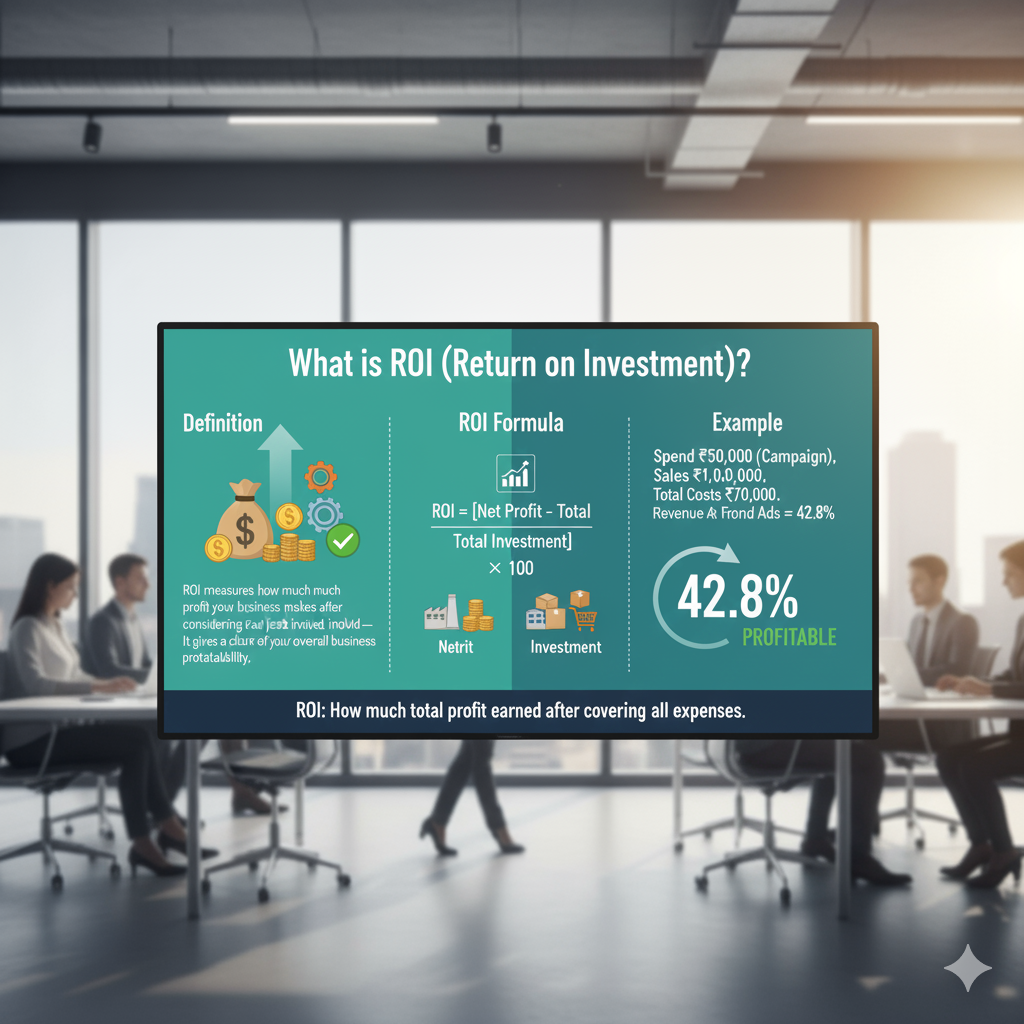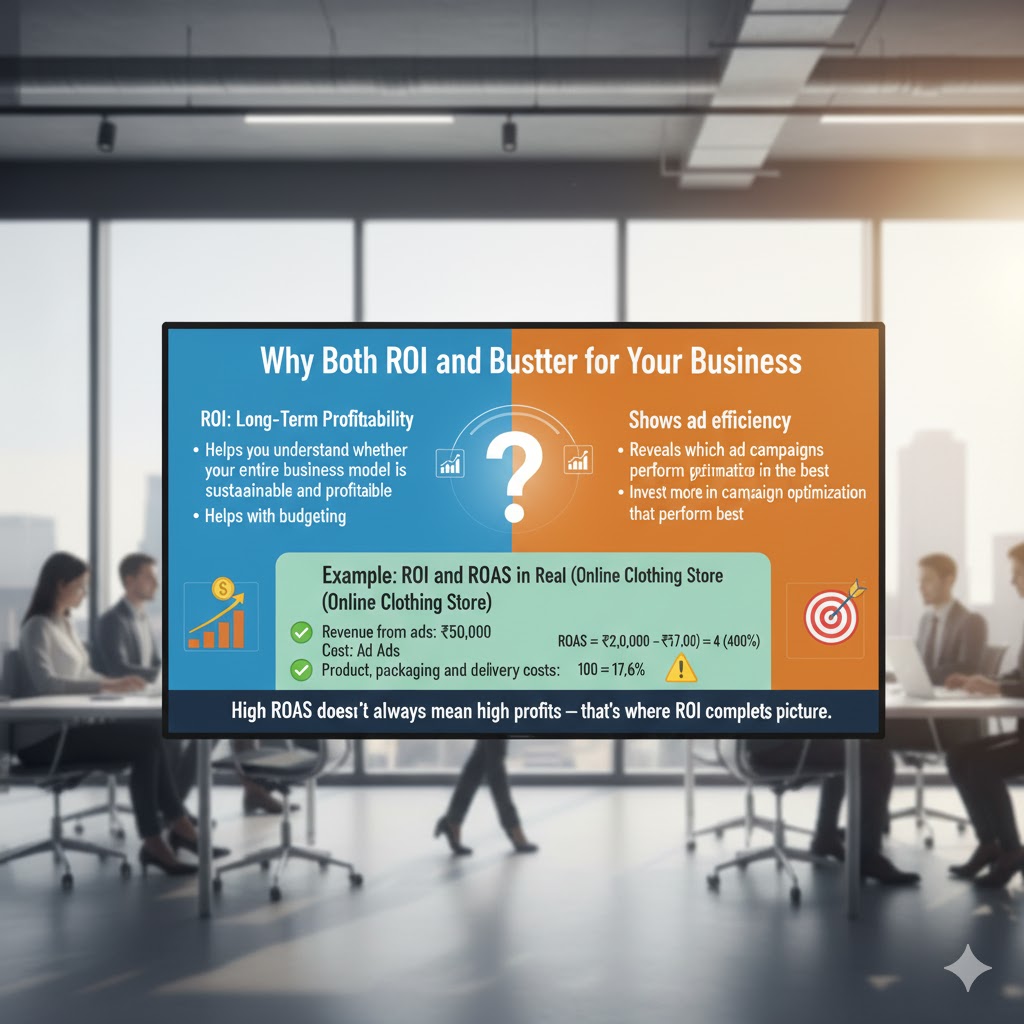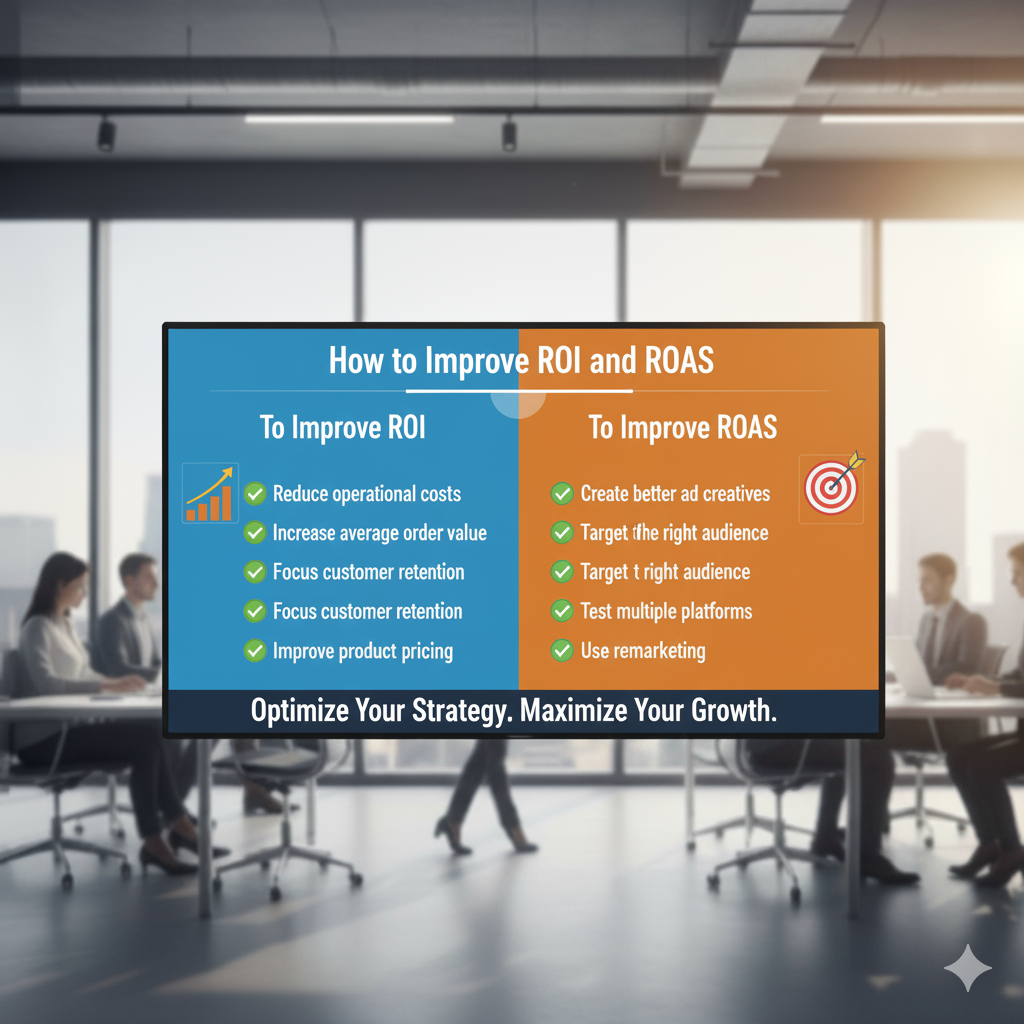
When it comes to digital marketing and advertising, two terms often create confusion — ROI (Return on Investment) and ROAS (Return on Ad Spend).
Both are essential performance metrics, but they measure different aspects of business success. Understanding the difference between them helps you spend smarter, earn more, and grow your business effectively.
What is ROI (Return on Investment)?

ROI measures how much profit your business makes after considering all costs involved — not just advertising. It gives a clear picture of your overall business profitability.
ROI Formula
ROI=(NetProfit−TotalInvestment)TotalInvestment×100ROI = \frac{(Net Profit – Total Investment)}{Total Investment} \times 100ROI=TotalInvestment(NetProfit−TotalInvestment)×100
Example:
If you spend ₹50,000 on a campaign and make ₹1,00,000 in sales, and your total costs (products, packaging, shipping, ads, etc.) are ₹70,000: ROI=(1,00,000−70,000)70,000×100=42.8%ROI = \frac{(1,00,000 – 70,000)}{70,000} \times 100 = 42.8\%ROI=70,000(1,00,000−70,000)×100=42.8%
That means your ROI is 42.8%, showing how profitable your overall business operation is.
In simple terms: ROI tells you how much total profit you earned after covering all your expenses.
What is ROAS (Return on Ad Spend)?

ROAS focuses only on how much revenue is generated from your ad spend.
It’s used mainly to evaluate the effectiveness of your marketing campaigns.
ROAS Formula
ROAS=RevenuefromAdsCostofAdsROAS = \frac{Revenue from Ads}{Cost of Ads}ROAS=CostofAdsRevenuefromAds
Example:
If you spend ₹10,000 on ads and earn ₹40,000 from those ads: ROAS=40,00010,000=4ROAS = \frac{40,000}{10,000} = 4ROAS=10,00040,000=4
That means your ROAS is 4:1 or 400% — you earn ₹4 in revenue for every ₹1 spent on advertising.
In simple terms: ROAS tells you how efficiently your ads are generating sales.
ROI vs ROAS — Comparison Chart
| Factor | ROI (Return on Investment) | ROAS (Return on Ad Spend) |
|---|---|---|
| Definition | Measures overall profit after all expenses | Measures revenue generated directly from advertising |
| Focus Area | Overall business profitability | Ad campaign performance |
| Includes | Ad spend, product cost, staff, packaging, delivery, etc. | Only advertising spend |
| Formula | (Net Profit ÷ Total Investment) × 100 | (Ad Revenue ÷ Ad Spend) |
| Result Type | Percentage (%) | Ratio (e.g., 4:1 or 400%) |
| Best For | Business owners and financial managers | Marketers and advertisers |
| Goal | Determine if the business is truly profitable | Determine if ads are delivering value |
| Scope | Broad — includes all costs | Narrow — focuses only on ads |
Why Both ROI and ROAS Matter for Your Business

ROI shows long-term profitability.
It helps you understand whether your entire business model — including production, marketing, and delivery — is sustainable and profitable.
ROAS shows ad efficiency.
It reveals which ad campaigns perform the best and bring the highest returns, helping you optimize your ad budget.
ROI helps with budgeting.
Knowing your ROI lets you decide whether to scale campaigns, cut costs, or explore new strategies.
ROAS helps in campaign optimization.
By comparing ROAS across ad platforms like Meta Ads or Google Ads, you can invest more in the channels that perform best.
Example: ROI and ROAS in Real Business
Imagine running an online clothing store and spending ₹50,000 on ads.
- Revenue from ads: ₹2,00,000
- Cost of ads: ₹50,000
- Product, packaging, and delivery costs: ₹1,20,000
Here’s how it looks: ROAS=₹2,00,000÷₹50,000=4(400ROAS = ₹2,00,000 ÷ ₹50,000 = 4 (400%)ROAS=₹2,00,000÷₹50,000=4(400 ROI=(₹2,00,000−₹1,70,000)÷₹1,70,000×100=17.6%ROI = (₹2,00,000 – ₹1,70,000) ÷ ₹1,70,000 × 100 = 17.6\%ROI=(₹2,00,000−₹1,70,000)÷₹1,70,000×100=17.6%
✅ ROAS is strong (4x) — the ads are performing well.
⚠️ ROI is moderate (17.6%) — your business is profitable, but operational costs could be optimized.
This example shows that both metrics tell different parts of the same story.
High ROAS doesn’t always mean high profits — that’s where ROI completes the picture.
How to Improve ROI and ROAS

To Improve ROI
- Reduce operational costs like packaging and delivery.
- Increase average order value with upselling or bundling.
- Focus on customer retention and repeat purchases.
- Improve product pricing and profit margins.
To Improve ROAS
- Create better ad creatives with clear messages.
- Target the right audience using precision marketing.
- Test multiple platforms to find the best-performing ones.
- Use remarketing to convert previous visitors.
Conclusion
Both ROI and ROAS play vital roles in evaluating business performance.
- ROAS helps you understand how effectively your ad spend generates revenue.
- ROI helps you determine your overall business profitability.
If you focus only on ROAS, you might think your ads are performing great even if your profit margins are thin.
If you look only at ROI, you might overlook powerful advertising opportunities that could drive long-term growth.
The real success comes when you analyze both ROI and ROAS together — optimizing ad campaigns for high ROAS while maintaining healthy overall ROI. This balance ensures steady, profitable growth for your business.
visit Samecart to explore tools and insights that help you track, analyze, and improve your ROI and ROAS effectively.